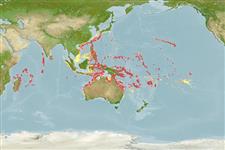Actinopterygii (ray-finned fishes) >
Beryciformes (Sawbellies) >
Holocentridae (Squirrelfishes, soldierfishes) > Myripristinae
Etymology: Myripristis: Greek, myros, -ou = male of morey eel + Greek, pristis = saw (Ref. 45335).
Environment / Climate / Range
Ecology
Marine; reef-associated; depth range 3 - 80 m (Ref. 9710), usually 15 - 80 m (Ref. 9710). Tropical, preferred ?; 32°N - 33°S, 42°E - 133°W
Indo-Pacific: mainly from oceanic islands, from the Mascarene Islands and Seychelles to French Polynesia and the Hawaiian Islands.
Size / Weight / Age
Maturity: Lm ? range ? - ? cm
Max length : 25.0 cm TL male/unsexed; (Ref. 30874)
Dorsal
spines
(total): 11;
Dorsal
soft rays
(total): 13-15;
Anal
spines: 4;
Anal
soft rays: 11 - 13. Interorbital space broad, 3.3-4.0 in head; inner pectoral axil naked; leading edges of median fins white (Ref 2334); lacks a dark opercular bar (except for perhaps a deeper red).
Forms large aggregations in caves and ledges of steep drop-offs; often in small groups and sometimes forms large schools (Ref. 48635). Benthopelagic (Ref. 58302). Individual is often swimming upside down, even when mixed in schools of non-inverted ones (Ref. 48635). Nocturnal and feeds on plankton.
Life cycle and mating behavior
Maturity | Reproduction | Spawning | Eggs | Fecundity | Larvae
Randall, J.E. and D.W. Greenfield, 1996. Revision of the Indo-Pacific holocentrid fishes of the genus Myripristis, with descriptions of three new species. Indo-Pac. Fish. (25):61 p. (Ref. 12419)
IUCN Red List Status (Ref. 115185)
CITES (Ref. 94142)
Not Evaluated
Threat to humans
Harmless
Human uses
More information
Common namesSynonymsMetabolismPredatorsEcotoxicologyReproductionMaturitySpawningFecundityEggsEgg development
ReferencesAquacultureAquaculture profileStrainsGeneticsAllele frequenciesHeritabilityDiseasesProcessingMass conversion
Tools
Special reports
Download XML
Internet sources
Estimates of some properties based on models
Phylogenetic diversity index (Ref.
82805): PD
50 = 0.5000 [Uniqueness, from 0.5 = low to 2.0 = high].
Bayesian length-weight: a=0.01820 (0.00819 - 0.04045), b=3.05 (2.87 - 3.23), in cm Total Length, based on LWR estimates for this Genus-body shape (Ref.
93245).
Trophic Level (Ref.
69278): 3.8 ±0.60 se; Based on food items.
Resilience (Ref.
69278): High, minimum population doubling time less than 15 months (Preliminary K or Fecundity.).
Vulnerability (Ref.
59153): Low vulnerability (19 of 100) .
